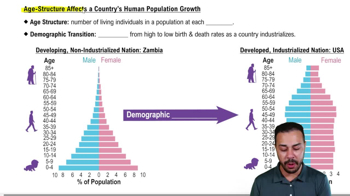The Human Population exam Flashcards
 Back
BackTerms in this set (27)
Human Population Growth
The increase in the number of individuals in the human species, which has accelerated due to advancements in agriculture, medicine, and technology.
What factors have contributed to the acceleration of human population growth?
Advancements in agriculture, medicine, healthcare, living conditions, and technology.
Density-Dependent Factors
Factors that affect population growth in relation to the population density, such as disease.
What is the significance of the 1960s in human population growth?
The rate of human population growth began to decline due to factors like disease and voluntary population control.
Voluntary Population Control
Methods such as contraception and policies that encourage smaller family sizes to control population growth.
Age Structure
The distribution of individuals of different ages within a population, often displayed as an age structure pyramid.
How does age structure affect population dynamics?
It impacts birth and death rates, life expectancy, and the overall growth rate of a population.
Developing Nations
Countries with high birth and death rates, leading to high mortality rates and low life expectancy.
What characterizes the age structure of developed nations?
More balanced age structure pyramids with relatively low birth and death rates, leading to high life expectancy.
Demographic Transition
The shift from high birth and death rates to low birth and death rates as a country industrializes.
Carrying Capacity
The maximum number of individuals that an environment can sustainably support.
Ecological Footprint
A measure of the amount of land and water needed to support human activities and absorb wastes.
What is a global hectare (GHA)?
A unit of area representing a hectare with world average biological activity, used to measure ecological footprints.
How is the maximum sustainable ecological footprint calculated?
By dividing the total globally productive hectares by the current human population size.
What is the estimated actual ecological footprint per person?
2.7 global hectares per person, which is greater than the maximum sustainable footprint of 1.5 global hectares per person.
Sustainable Practices
Actions that reduce ecological footprints and ensure resources are used in a way that can be maintained over the long term.
What are some examples of sustainable human activities?
Using bicycles for transportation, renewable energy sources, less deforestation, and using crops as primary food sources.
What are some examples of environmentally demanding human activities?
Using individual cars, coal-burning factories, deforestation, using animals as primary food sources, and oil spills from cargo ships.
Why is it important to be aware of our ecological footprint?
Awareness helps us reduce our ecological footprint and promote sustainable practices to support future populations.
What is the impact of high birth and death rates in developing nations?
It leads to high mortality rates, low survivorship, and low life expectancy.
How does industrialization affect demographic transition?
It leads to a shift from high birth and death rates to low birth and death rates, increasing life expectancy.
What does an age structure pyramid reveal about a country?
It provides insights into the country's development, birth and death rates, and population growth trends.
What is the projected trend for human population growth rate through 2050?
The growth rate is projected to continue decreasing.
What does a bottom-heavy age structure pyramid indicate?
It indicates a developing nation with high birth rates and high death rates.
What does a balanced age structure pyramid indicate?
It indicates a developed nation with low birth rates and low death rates.
What is the significance of ecological footprints being greater than the maximum sustainable footprint?
It indicates that humans are using resources faster than nature can regenerate them, leading to potential environmental collapse.
What is the role of global hectares in measuring ecological footprints?
They standardize measurements, allowing comparisons of ecological footprints across different regions and countries.



